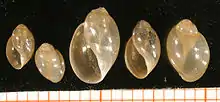Physa
Physa is a genus of small, left-handed or sinistral, air-breathing freshwater snails, aquatic pulmonate gastropod mollusks in the family Physidae.
| Physa Temporal range: Upper Cretaceous-Holocene | |
|---|---|
 | |
| Five shells of Physa fontinalis | |
| Scientific classification | |
| Kingdom: | |
| Phylum: | |
| Class: | |
| (unranked): | |
| Superfamily: | |
| Family: | |
| Subfamily: | Physinae |
| Tribe: | Physini |
| Genus: | Physa Draparnaud, 1801[1] |

Anatomy
Members of the freshwater pulmonate family Physidae possess a complex of muscles that is unique amongst gastropods. This complex was given the name "physid musculature". The physid musculature has two main components, the physid muscle sensu stricto and the fan muscle. The physid musculature is responsible for a unique ability of physids to rapidly flick their shells from side to side — a reaction that frequently enables them to escape predation.
Shell description
These small snails, like all the species in the family Physidae, have shells that are sinistral, which means that when the shell is held with the spire pointing up and the aperture facing the viewer, then the aperture is on the left-hand side.
The shells of Physa species have a long and large aperture, a pointed spire, and no operculum. The shells are thin and corneous, and rather transparent.
Species
Species in the genus include:
- Physa acuta Draparnaud, 1805
- Physa ancillaria (Say, 1825) - Pumpkin Physa[2]
- † Physa aridi Mezzalira, 1974 - fossil from Brazil[3]
- Physa carolinae Wethington, Wise & Dillon, 2009[4]
- Physa concolor
- Physa fontinalis (Linnaeus, 1758) - Fountain bladder snail - type species
- Physa hordacea (I. Lea, 1864)
- Physa jennessi Dall, 1919
- Physa lordi (Baird, 1863)
- Physa marmorata Guilding, 1828[5] - synonyms: Physa mosambiquensis Clessin, 1886 and Physa waterloti[5]
- Physa megalochlamys Taylor, 1988 - Cloaked physa
- † Physa mezzalirai Ghilardi, Carbonaro & Simone, 2011 - fossil from Brazil[6]
- Physa natricina Taylor, 1988
- Physa nuttalli
- Physa propingua (Tryon, 1865)
- Physa pumilia Conrad, 1834
- Physa siberica Westerlund, 1876
- Physa skinneri Taylor, 1954
- Physa vernalis Taylor et Jokinen, 1984
- Physa sp., Lake Winnipeg Physa, lives in Manitoba in Canada. It was classified as endangered by COSEWIC. COSEWIC recommendation has been forwarded to the Minister of the Environment of Canada and a decision for listing at the List of Wildlife Species at Risk of the Canadian Species at Risk Act was pending in 2005.[7]
Synonyms:
- Physa acuta Draparnaud, 1805, Physa heterostropha (Say, 1817), Physa integra (Haldeman, 1841) and Physa natricina Taylor, 1988 are synonyms of Physella acuta (Draparnaud, 1805)
- Physa columbiana (Hemphill, 1890) is a synonym for Physella columbiana (Hemphill, 1890)
- Physa gyrina (Say, 1821) is a synonym for Physella gyrina'' (Say, 1821)
References
- Draparnaud J. P. R. (1801). Tableau des mollusques terrestres et fluviatiles de la France. - pp. [1-2], 1-116. Montpellier, Paris. (Renaud; Bossange, Masson & Besson).
- "Physella". NatureServe Explorer, accessed 9 April 2010.
- Simone L. R. L. & Mezzalira S. (1994). "Fossil Molluscs of Brazil". Boletim do Instituto Geológico 11: 1–202.
- Wethington A. R., Wise J. & Dillon R. T. (2009). "Genetic and morphological characterization of the Physidae of South Carolina (Pulmonata: Basommatophora), with description of a new species". The Nautilus 123: 282-292. PDF Archived 2012-08-23 at the Wayback Machine.
- Appleton C. C. & Dana P. (2005). "Re-examination of Physa mosambiquensis Clessin, 1886 and its relationship with other Aplexinae (Pulmonata: Physidae) reported from Africa". African Invertebrates 46: 71-83. abstract Archived 2010-11-04 at the Wayback Machine
- Ghilardi R. P., Carbonaro F. A. & Simone L. R. L. (2011). "Physa mezzalirai, a new cretaceous basommatophoran from Adamantina formation, Brazil". Strombus 18(1-2): 1-14. abstract.
- COSEWIC. 2005. Canadian Species at Risk. Committee on the Status of Endangered Wildlife in Canada. 64 pp., page 13.
- Janus, Horst, 1965. ‘’The young specialist looks at land and freshwater molluscs’’, Burke, London
External links
| Wikimedia Commons has media related to Physa. |
- http://www.animalbase.uni-goettingen.de/zooweb/servlet/AnimalBase/list/species?taxongenus=301
- Dillon R. T., Wethington A. R. & Lydeard C. (2011). "The evolution of reproductive isolation in a simultaneous hermaphrodite, the freshwater snail Physa". BMC Evolutionary Biology 11: 144. doi:10.1186/1471-2148-11-144.
